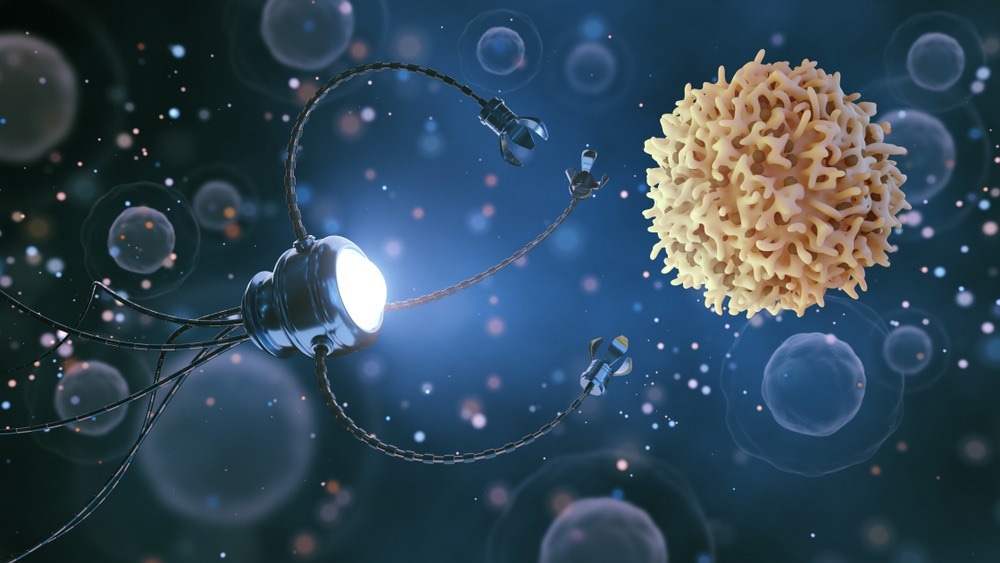Conventional chemotherapeutics kill both cancerous and healthy cells and cause several side effects in patients. The negative effects limit the maximum tolerated drug dose, compromising its optimal therapeutic efficacy.

Study: Endogenous Stimuli-Responsive Autonomous Separation of Dual-Targeting DNA Guided Missile from Nanospacecraft for Intelligent Targeted Cancer Therapy. Image Credit: K_E_N/Shutterstock.com
In a recent ACS Applied Materials and Interfaces study, scientists sought to address this challenge and developed a dual-targeting intelligent DNA-guided missile (GM)-integrated nanospacecraft (NSC), which can deliver chemotherapeutic drugs precisely to cancer cells and mitochondria.
Limitations of Conventional Chemotherapeutics for Cancer Therapy
In the past few decades, conventional chemotherapeutics have been used as the first line of standard treatment for a wide range of malignancies. One of the commonly used drugs is doxorubicin (Dox), which exhibited desirable therapeutic efficacy against malignancies. Mechanistically, this drug interferes with nucleic acid synthesis in cancerous cells.
Although conventional chemotherapeutic drugs can efficiently eliminate cancerous cells, they also affect non-cancerous cells significantly. Off-target effects are associated with the non-specific distribution of chemotherapeutic drugs throughout the body via blood circulation, which causes severe damage to healthy cells, tissues, and organs. Due to the off-target effects of standard chemotherapeutic drugs, clinicians lower the drug dose required to eliminate all cancer cells, which inevitably compromises the therapeutic efficacy.
Most chemotherapeutics require identifying specific organelles and cellular compartments to induce expected therapeutic responses. For instance, the clinical efficacy of paclitaxel is exerted via the inhibition of microtubule depolymerization in the cytoplasm.
Several human cancers have been linked with mitochondrial dysfunctions, such as insensitivity to anti-growth signals, uncontrolled cell proliferation, decreased autophagy, and enhanced anabolism. The malignant properties of cancer cells are associated with a high reactive oxygen species (ROS) level, which can promote drug resistance. Recently, mitochondria have been considered to be a potential target for anticancer drugs, including Dox.
Limitations of Nanocarrier Drug Delivery Systems Used for Cancer Therapy
Nanocarriers, such as liposomes and polymers, are used to minimize the off-target side effects caused by conventional chemotherapeutics. These nanocarriers promote targeted tumor therapy, which reduces side effects and maximizes therapeutic efficacy.
Nanoscale drug delivery systems have significantly enhanced targeted drug delivery through their capacity to recognize tumor cells and improve the bioavailability of drugs at the target site
Although nanocarriers can target tumor cells, the majority of them cannot transport antitumor drugs into subcellular organelles (e.g., mitochondrion). To overcome this limitation, there is a need to develop a targeted drug-delivery system that can deliver anticancer therapeutics into specific cellular organelles.
A recent study indicated that gold nanoparticles (AuNPs) functionalized with oligonucleotides (DNA-AuNP) can penetrate almost all mammalian cells and when engineered with targeting ligands, can target specific cancer cells as well.
Development and Function of GM-Nanospacecraft (GM-NS) for Tumor Therapy
Recently, scientists developed GM-NSC, a dual-targeting DNA-guided missile integrated nanospacecraft. GM-NSC promotes targeted mitochondrial drug delivery along with simultaneous cancer imaging by combining DNA tetrahedron (Tetra) with functional DNA-AuNP. DNA tetra serves as precise guided missiles in the new nano-based drug carrier system.
GM-NSC is a nanocomposite containing Au-NPs, surrounded by dense multilayers of DNA crowns that are self-assembled from DNA tetra in an orderly fashion. Each tetrahedral DNA structural unit was equipped with three functional components, namely, a hidden mitochondria-targeting triphenylphosphonium (TPP), an explosive bolt (E-bolt), and a cancer cell-targeting aptamer pointing toward the outer environment. E-bolt has been assembled from the Lock strand, DNAzyme, and cleavage substrate.
The L-DNAzyme/Bridge-AuNP (DB-AuNP) served as the nanospacecraft core, while-DNAzyme/Bridge hybrid acted as E-bolt, which could explode (cleavage) upon endogenous stimuli. A total of four DNA components, i.e., S1-Apt containing AS1411, S2, S3- TPP, and S4, were used to assemble functional DNA Tetra.
A tumor-bearing mouse model was administered with the GM-NSC loaded with Dox. Due to the long circulation time, the aptamers could precisely direct these nanosystems to the targeted cell where systemic drug delivery occurred. Mechanistically, AS1411 could specifically bind to nucleolin, overexpressed on cancer cell membranes, with high affinity.
Dox-loaded GM modified with TPP was able to precisely penetrate mitochondria and promote the mitochondrial accumulation of Dox, which ultimately damaged mitochondria by ROS generation and lowering of mitochondrial membrane potential. Subsequently, cytochrome c was released into the cytoplasm, which activated apoptosis-related enzymes caspase-9 and caspase-3. These activated enzymes triggered a cascade of molecular events causing tumor cell apoptosis.
Importantly, GM-NSC was found to be stable in a fetal bovine serum solution for over 12 hours. A single GM-NSC unit exhibited significantly enhanced drug loading capacity. The systemic administration of dox-loaded GM-NSC into a tumor-bearing xenograft murine model revealed improved target specificity by 18-fold. Around 80% of the drug was uptaken and transferred into mitochondria, leading to mitochondria-mediated apoptosis. 100% of malignant tumor growth was inhibited without any detectable toxicity to healthy tissues.
Taken together, the desirable systemic stability, high cargo loading capability, good biocompatibility, suitable in vivo biodistribution, and significant therapeutic efficacy without detectable adverse effects makes GM-NSC a potential drug delivery system for precision cancer therapy.
Reference
Sun, S. et al. (2022) Endogenous Stimuli-Responsive Autonomous Separation of DualTargeting DNA Guided Missile from Nanospacecraft for Intelligent Targeted Cancer Therapy. ACS Applied Materials and Interfaces. https://pubs.acs.org/doi/10.1021/acsami.2c13624
Disclaimer: The views expressed here are those of the author expressed in their private capacity and do not necessarily represent the views of AZoM.com Limited T/A AZoNetwork the owner and operator of this website. This disclaimer forms part of the Terms and conditions of use of this website.